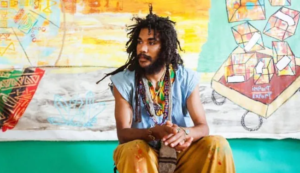
Malcolm Emilio is a self-taught artist – an artistic denizen of the Kensington Market neighbourhood. He’d frequently have fruit with him — but not just to eat. He’d use the rinds to move paint around the canvas.
He was “discovered” by Toronto’s Liss Gallery. Malcolm Emilio (who goes by his two first names) is now represented by the Yorkville gallery, which hosted a solo exhibition of his paintings last summer. And it’s all because he skated up to that high-end neighbourhood one day, canvas in hand. Passersby, including one influential person from the gallery, were quickly captivated by this Rastaman with the experimental style.
His work pops with colour. The playfulness of his childlike imagery invites the viewer to consider the political undertones of his work. He’s a sort of a magical figure, conjuring works with the same ingredients he’d use to make a vegan meal, and he often speaks passionately of crystals and a non-Western colour theory.
These days, Malcolm Emilio spends less time in the Market. He has traveled to Central and South America, the Caribbean and the United States in the last four years, and he is often commissioned to make large-scale murals for hospitals and community centres while abroad. The self-taught painter shared the story of how he launched his career by painting in the street.
Emilio said that he got connected with the Liss Gallery while, “Painting outside! So I’m painting, one of my first times going to Yorkville because I was always like, “I wonder what the vibes is over there?” And this gentleman comes out and he’s like, “How much are you selling that painting for? 10,000, right?”
I looked at him and I was just like, “Well, you know if that’s what it is then that’s what it is.” He gave me like a quick two-minute [talk] saying, “Hey, you gotta know where you are. If someone comes and talks to you, it’s because they want that and not because they like it.”
Within [a] couple of minutes of him opening that window, [another] gentleman walks up. “How much you want for that?” And I look up to him and I was just like, “$2,000?” He’s like, “That it? Come hang that at my gallery when it’s done.” And I was like, “Your what?” So I finished up the painting and walked over there and sure enough, [he] put it up in the front window — and that was kind of the start.
Given the way he expresses himself sometimes leads to his art being misunderstood or misconstrued.
Yes, he said, “I had my solo show with the gallery last year. So all my descriptions are up and [the gallery] is calling me like two hours before the show, like, “Malcolm. There’s a word here in all of the descriptions and I don’t know what it means. I don’t know what it says.” He’s like “Meline… Melin… Mela… Melanine.” He was not familiar with word.
Emilio said, “You’ll probably be the only one at that show that doesn’t know what that word is.” So when I’m in a place where I’m talking about my art and I’m asked to filter that, I’ve just had to gauge different levels of what that filtration meant — have an articulation that gives people better reference points of what you’re saying.
He said he began creating art after he was kicked out of high school when was “young.” They said he was a distraction to the other kids in the class. They said h talked too much. In his words he said he was a class clown. The same thing happened in adult school. “So I took a chance to start working and create my own brands, my own clothes — and the artwork became an expression.”
His mother noticed the quality of his T-shirt paintings and encouraged him to paint on canvas. He spent his days in his room painting. One day he said he couldn’t stop working on this piece. “So I took it to the alternative school I went to just to get my GED and one of the teachers was like, ‘I want to buy that.’” I’d never thought of selling my art — I would just do these shaking techniques of the canvases and I would blow. That’s when [I started using] the fruit peels. I would just try so many different things.”
He said that he had never heard of Picasso or Basquiat or such names. Then when he moved back to Toronto, that’s when I saw Basquiat and that’s when I saw the AGO and that’s when I was like, “Oh, there’s a whole art world.” I was clueless to art.
The rest is history.


